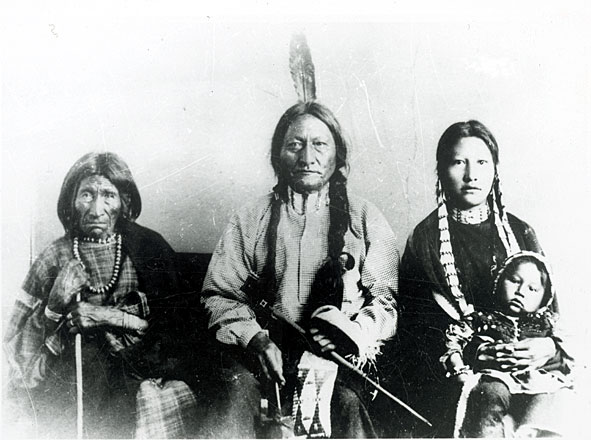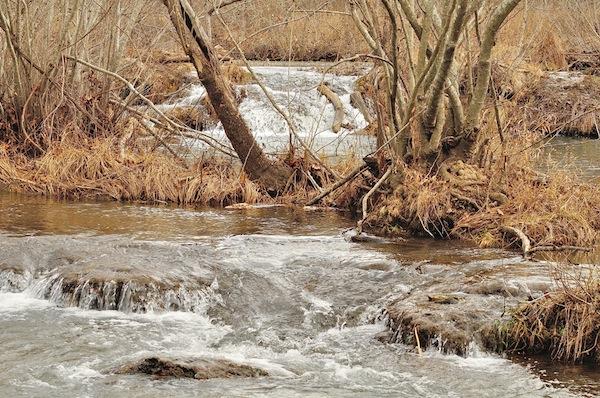Tag: Chickasaw
5 Native American Communities Who Owned Enslaved Africans
April 9, 2014 | Posted by Barbara-Shae Jackson
The Atlanta Black Star
Stories about Black and Native American connections are rarely told within the narrow historical context shared in classrooms, history books and around family tables, but there are some details that reveal a more complete story of enslavement in the Americas.
In the 1830s, the enslavement of Blacks was established in the Indian Territory, the region that would become Oklahoma. By the late 19th century, when over half a million Africans were enslaved in the South, the southern Native American societies of that region had come to include both enslaved Blacks and small numbers of free Black people.
Though the harsh treatment of enslaved Africans largely paled in comparison to that of white slaveholders, Blacks still were treated as an underclass among Native Americas. The Five Civilized Tribes even established slave codes that protected owners’ property rights and restricted the rights of Blacks.
Here are the Five Civilized Tribes who held Black people as slaves.

Chickasaw
It is no surprise that the Native Americans knew the land well. Their knowledge became a lucrative business, especially for the Chickasaws who had keen navigation skills. They were hired by white slaveholders to traverse the terrain to capture Blacks who had escaped slavery.
The Chickasaw also held enslaved Africans of their own, and the system they established closely approximated that of white slaveholders on cotton plantations.
For rest of list please click here.
Chickasaw Fishery Saves Endangered Species While Sustaining Fishermen and Tourism
Nothing elevates the hope and heart rate of an angler more than hearing that first predawn “ZWIIINNGGG” of a casting reel as fishing line slices through the early morning air and the lure plops into the water.
Whether it’s the first or last day of the season, fishermen hope that is a dinner bell ringing in the ears of their desired quarry.
The outdoor enthusiasts who pursue a multitude of game fish seeking refuge in coves, holes and brush in Oklahoma’s lakes and streams make a sound too: The cash register’s “cha-CHING” can be heard with predictable regularity.
With more than 700,000 anglers using the many public lakes, ponds and streams within Oklahoma each year, work is underway to guarantee the state’s natural fish resources will exist for generations to come. These efforts incorporate fish hatcheries located throughout the state, including the Tishomingo National Fish Hatchery.
The national hatchery was established in 1929 on lands purchased from Native Americans. Located less than 15 minutes from the city of Tishomingo, it has been named in honor of Chickasaw Chief Tishomingo—one of the tribe’s most celebrated leaders.
Hatcheries play a major role in preserving imperiled species and provide millions of fish for recreational purposes. The Tishomingo National Fish Hatchery is one of only 70 fish hatcheries managed by the U.S. Fish and Wildlife Service. Each hatchery is unique, but all work to protect and conserve fish populations within the United States.
“Our hatchery is different from most for a couple of reasons,” biologist Brian Fillmore said. “While we do raise recreational fish, national hatcheries focus on threatened, endangered and species of special interest. Included are paddlefish and alligator snapping turtles, a non-fish species. Also, the water we use is gravity fed to our ponds, so we don’t have the added cost and headache of large water pumps.”
The hatchery sits on the banks of historic Pennington Creek in Johnston County. The location is a natural choice for the hatchery. Pennington Creek has a continuous flow of water provided by the Arbuckle Simpson Aquifer. The hatchery relies on the aquifer to provide clean, cool and pristine water, even during extreme drought. The creek flows through the heart of Chickasaw lands, making its way through the historic capital of the Chickasaw Nation, Tishomingo. The water is cleaned through natural processes once used by the hatchery.
“The hatchery is careful with the water we use and the local environment,” Fillmore said. “Once used, the water flows through an affluent that catches solid particles within it. The water released is tested by the state. It is as clean and pure as when it first arrives. We also take steps to make sure fish not native to Pennington Creek don’t get loose.”
According to the U.S. Fish and Wildlife Service, the hatchery is bordered by 3,400 acres in a conservation easement on the north that protects Pennington Creek and other area watersheds.
With more than 50 ponds located on 235 acres and a staff of eight full-time employees, the hatchery breeds many types of fish. They include the prehistoric paddlefish, catfish, alligator gar and alligator snapping turtle. The hatchery has a captive breeding and rearing program for threatened and endangered populations, including the Arkansas River shiner, which resembles a minnow.
“We are always trying new ways to raise fish, as well as different kinds of aquatic animals,” Fillmore said. “We are developing programs for the endangered Arkansas river shiner and leopard darter. We also raise alligator snapping turtles, a species most people would not think to be raised at a hatchery.”
Vital information is collected at the hatchery for protecting and managing the diverse types of wildlife found in the Arkansas and Red River basins. Both flow into the Mississippi River, which runs through the historic Homeland of the Chickasaw.
The hatchery visitor center is open to the public year-round. Aquariums, photographic exhibits, aquatic ecosystems and a display pool with various types of fish are present at the hatchery. For the adventurous, a scenic area with fishing access and a hiking trail is available. The trail was constructed by the Boy Scouts of America and the Chickasaw Youth Program.
Children from 6-12 years of age can participate in the annual Kids Fishing Derby at the Tishomingo National Fish Hatchery during National Fishing Week in June. Popular among visitors is the historic gristmill water wheel maintained by the hatchery. Visitors may enjoy watching it operate on the banks of Pennington Creek while touring the hatchery grounds.
“In the 1930s, there used to be an amusement park of sorts adjacent to the hatchery,” Fillmore said. “Near the water wheel was a miniature golf course, surround by outbuildings. The only thing left from that time is the grist wheel. We keep it maintained for its historical value.”
Guided tours are available from 8 a.m. to 2:30 p.m. Monday through Friday, except federal holidays. For large groups, call ahead as weather and scheduled job duties can affect availability of hatchery staff. For more information, contact the Tishomingo National Fish Hatchery at (580) 384-5463 or read about the hatchery at the Fish and Wildlife Service page devoted to it.
Read more at http://indiancountrytodaymedianetwork.com/2014/02/16/chickasaw-fishery-saves-endangered-species-while-sustaining-fishermen-and-tourism-153565?page=0%2C2
Chickasaw Woman to Cheer On NBA Pros as Thunder Girl

TheAdaNews.com
Katie Callaway, of Oklahoma City, during her audition for the NBA’s Oklahoma City Thunder Girls
A Chickasaw woman’s dream has come true. And she’ll get to share it with thousands.
Katie Callaway will cheer on basketball pros and fans as a member of the NBA’s Oklahoma City Thunder’s dance team.
“I am so excited,” Callaway said in a news release. “I can’t wait to get on those sidelines and entertain the best fans of any city with an NBA team.”
Callaway, 26, sat in the stands as a fan for six years before she decided to try out. But, she didn’t make the team on her first try.
“I worked hard, very hard, to improve my technique,” Callaway said reflecting on the failed effort. “I worked on leaps, turns, and pointed toes. It was a full-on effort for a year. It was tough.”
The final audition process consisted of three rounds: a choreographed routine, a question and answer session, and a solo dance. Only 38 women were selected as finalists from nearly 100 hopefuls. The group of 38 was eventually narrowed down to 20.
She auditioned at the Riverwind Casino in Norman, Oklahoma in front of a packed house. Now that she’s one of the 20 Thunder Girls, Callaway is looking forward to the team’s first game in November.
“I wondered what it would be like to be down there. I wondered how exciting it was for the team and how much they looked forward to it,” she said in the news release.
Callaway is an Oklahoma resident. She attended Ada High School where she was a cheerleader, but she was born in England where her father was stationed in the U.S. Air Force. Her mother is Chickasaw and works for the Chickasaw Nation. For years, her grandfather, Jack Wells, served as a Chickasaw tribal legislator and her great-grandmother, Delta Wells, was an original enrollee with the tribe.
“We’d go to festivals and I was a member of the Governor’s Honor Club,” Callaway said. “I learned my heritage is important and tradition is important. It is essential to know one’s self. I am very proud of my Chickasaw heritage.
But, Callaway won’t quit her day job. She’s a drilling engineer technician with Chesapeake Energy where she analyzes drilling for natural resources. She started working there as a receptionist and moved up rather quickly. Callaway is also a graduate of the University of Central Oklahoma in Edmond where she studied public relations.
Not only is she excited about cheering on the fans, but as a Thunder girl, Callaway will also have a chance to work with her community. “Being a part of the organization will give me that opportunity to give back, which is something I’m looking forward to very much.”
Read more at http://indiancountrytodaymedianetwork.com/2013/10/02/chickasaw-woman-cheer-nba-pros-thunder-girl-151566



